Misattributed and overlooked: A rare necessity issue is looking for its rightful place among the Mexican War for Independence issues
by Ralf W. Böpple
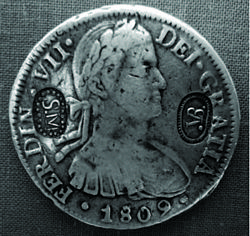
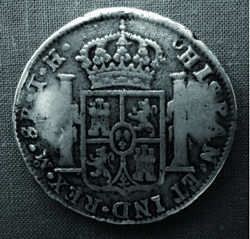
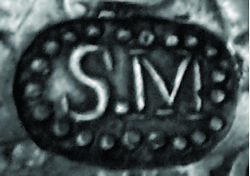
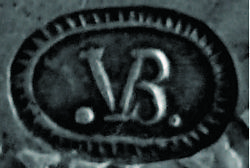
![]()
Mexico. War for Independence.
8 Reales, n. d. – Mint of San Miguel Tenango / Vicente Beristáin
Countermarks “SM” in oval dotted circle and “VB” in oval serrated circle on the obverse of
a cast silver Mexico City 8 reales of 1809, crudely reeded edge, 27.58gm
This coin is a very rare issue of one of the makeshift mints of the War for Independence period, and it has been overlooked ever since by collectors. This is due to the fact that, starting with the very first catalogs on Spanish Colonial coins, it was misattributed and even placed with locations outside of Mexico.
The coin in numismatic literature
The first reference to this coin is found in the catalog of the Vidal Quadras y Ramón collection (Barcelona, 1892), vol. III, p. 125, No. 10,943. An 1809 cast is shown and described under the heading “Santa Marta”, a Caribbean coastal town in northern Colombia. The attribution to Santa Marta may be deduced from the design of the necessity issues that had been attributed to that location in the earlier work of Heiss, Descripción general de las monedas hispano-christianas (Madrid, 1865). These coins – quarter and half reales in copper and a silver two reales of the macuquina or cob type - bear the mint mark “SM” and, in particular, one of the 1 real coppers shows a reverse design of the letters SM in a beaded circle that bears a striking and – at least for the early cataloguers – convincing resemblance to the countermark on the left of our coin.
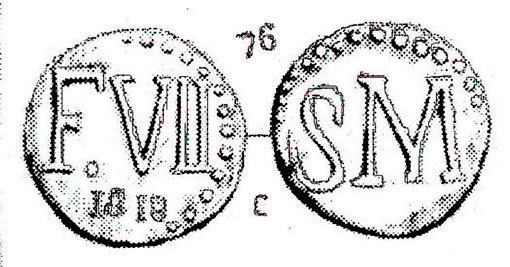 Reverse of the Santa Marta, Colombia necessity issue that may have been the reason for the attribution of the coin to this place by 19th century numismatists (line drawing taken from Heiss, plate 67, No. 76)
Reverse of the Santa Marta, Colombia necessity issue that may have been the reason for the attribution of the coin to this place by 19th century numismatists (line drawing taken from Heiss, plate 67, No. 76)
Herrera (El Duro, Madrid, 1914) has an entry for these counterstamps on page 123 under Santa Marta, citing a corresponding entry in the Meili catalog (J. Schulman sale of the Meili Collection, Amsterdam, 1910). However, he states that “today it is known that they correspond to coins fabricated by Vicente Beristáin in San Martín Texmelucan”, then lists two of these coins as issues under Fernando VII on page 232 (numbers 745 and 749, described as “fabricado en San Martín Texmelucan”). No. 745 (no picture) is the Vidal Quadras y Ramón coin, No. 749 is a cast from an 1810 host and is depicted on table XVII. How he came to this conclusion, and when, is not stated.
Medina in his Monedas Obsidionales Hispano-Americanas (Santiago de Chile, 1919) has an entry on Santa Marta with the smaller denominations mentioned above, but does not make any reference to our 8 reales in question, neither there nor elsewhere in his book.
Pradeau (Numismatic History of Mexico, Los Angeles, 1938) does not list our coin. If the author thought the coins and counterstamps to be of Colombian or otherwise non-Mexican origin, he would not have included it in his work, so this omission was most likely intentional. On the other hand, he does make a reference to Beristáin. He translates a letter from Beristáin to Morelos dated 3 November 1812 (in Hernández y Dávalos, Vol. IV, No. 152, pp. 660-661) in which Beristáin reports having turned into coins (“he sellado”) 22 of the silver bars taken during an attack on Pachuca (p. 116). Pradeau knew of the Herrera book, which he quotes extensively throughout his work. Yet he does not link Herrera’s mentioning of Beristáin with his translation of Beristáin’s letter to Morelos. Had he done so, our story most likely would have come to an early end here!
The next standard work on Spanish colonial coinage came out of the old world again. Dasí (Estudio de los Reales de a Ocho, Valencia, 1951) places the coins firmly with Santa Marta in Colombia. He describes and illustrates three examples in Vol. IV under No. 1379. The first is the Vidal Quadras y Ramón coin, now described as residing in the Yriarte collection. The second is the Herrera coin, and the third, also on a cast 1810 host, is from the collection of the Fábrica Nacional de Monedas y Timbres in Madrid. This coin carries an additional mark applied twice, the unidentified counterstamp of the letter H surrounded by dots (see image below).
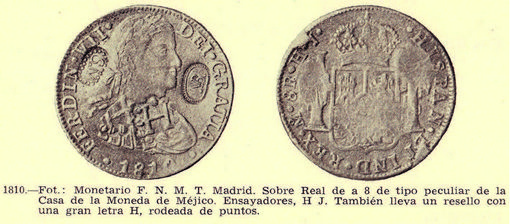
It is worthwhile pointing out that Dasí never mentions that the host coins are cast copies and not original Mexico City mint products, although this can easily be observed from the pictures alone.
Dasí also provides documentary evidence which he interprets as an explanation for the attribution to Santa Marta. According to these sources, the coins could have been part of a shipment sent in 1813 from Panama to the Royalists in Santa Marta, of “30.000 pesos of a coin of special design, produced by the insurgents of New Spain…”. The fact that none of the host coins bear a date later than 1813 is taken as further support of this argument.
The next sources are the respective entries in Burzio (Diccionario de la moneda hispanoamericana, Santiago, 1956-1958). While of a later publication date than Dasí, it does not make any reference to him. Most likely, Burzio did not know of Dasí’s work at the time he finished compiling and editing his Diccionario, and we should regard the two works as parallel publications. Burzio presents the coin under Santa Marta, but he also provides a detailed account of the discussion that had developed concerning it (or rather, over the “SM” stamp) among numismatists of the New World: Howland Wood of the ANS had also attributed it to the island of Margarita in the Lesser Antilles, an argument that was in turn refuted by Venezuelan numismatist Rafael Fosalba who correctly pointed out that the island was never called Santa Margarita and thus cannot have been the source for the “SM” abbreviation. Quite interestingly, while Burzio provides a résumé of the “SM” discussion and goes as far as citing the entries of Herrera for this coin, he completely ignores the Texmelucan attribution and even goes on to speculate that the letter VB might stand for a nowadays unknown person responsible for assaying and guaranteeing the correct silver weight of the coin – thus ignoring Herrera’s mentioning of Vicente Beristáin as well!
So, with the foundations cemented by Dasí and Burzio, at least for the next two decades the coin remained firmly placed with Colombia in numismatic literature.
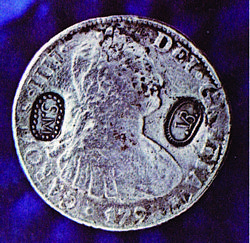 While Raymond (The Silver Dollars of North and South America, 2nd ed., Racine, 1964) does not list it at all, Elizondo (Eight Reales and Pesos of the New World, 2nd edition, San Antonio, 1971) shows an 1809 coin (but fails to describe it as cast) under Santa Marta. So do Yriarte and López-Chaves (Catálogo de los Reales de A Ocho Españoles, Madrid, 1965, p. 256), using an 1810 cast for the illustration and not the ex-Vidal Quadras y Ramón coin supposedly in the Yriarte collection.
While Raymond (The Silver Dollars of North and South America, 2nd ed., Racine, 1964) does not list it at all, Elizondo (Eight Reales and Pesos of the New World, 2nd edition, San Antonio, 1971) shows an 1809 coin (but fails to describe it as cast) under Santa Marta. So do Yriarte and López-Chaves (Catálogo de los Reales de A Ocho Españoles, Madrid, 1965, p. 256), using an 1810 cast for the illustration and not the ex-Vidal Quadras y Ramón coin supposedly in the Yriarte collection.
In Mexican coin catalogs, Utberg (Coins of Mexico, 1963) does not list it, nor does Grove (Coins of Mexico, 1981). However, in another publication (Numismatic Sidelines, 1965, p. 74), Utberg shows photographs of three different coins in the Banco de Mexico collection, on cast hosts of 1811, 1812 and a Carlos IV 8 reales of 1794, respectively. By this we learn that even the numismatists at the Mexican central bank had accepted the attribution to Colombia at that time. This is reiterated in Sobrino (La Moneda Mexicana – Su Historia, Mexico, 1972), where a color photo of the 1794 cast in the Banco de México collection is shown, again with reference to Santa Marta.
In Bruce and Vogt’s Standard Catalogue of Mexican Coins, Paper Money, Stocks, Bonds and Medals, both the 1st and 2nd editions (1981 and 1985) list the coin under Colombia in the section of Trade Dollars.
Yet already a decade earlier, the first voices had appeared challenging the attribution to Colombia. This happened most prominently in the Superior Stamp & Coin Pradeau-Bothamley sales (Part III, 2-6 November, 1971, lot 1890, the host coin being a cast 1810 8 reales), where the cataloguers provide a lengthy argument and state that they regard this issue as coming from “an Insurgent commander, probably Vicente Beristáin”. According to them, the “SM” countermark could belong to one Dr. José de San Martín, Inspector of the State of Oaxaca.
Why and by whose initiative the coin was placed (back?) with San Martín Texmelucan in the following years is unclear. But we observe that the coin type appears twice in Richard Long auctions in the 1990s under Texmelucan (Sale 87, 1998, lot 174 and Sale 88, 1999, lot 152).
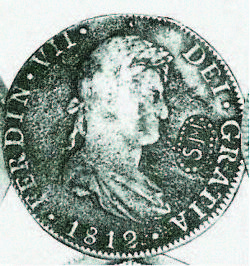 Finally Calicó (Numismática Española) catalogued the coin from their 9th edition (1998) onwards in the section of Fernando VII under “Ceca de San Martín Texmelucan“ and thus granted the coin the status of having originated from a particular mint of the New World.
Finally Calicó (Numismática Española) catalogued the coin from their 9th edition (1998) onwards in the section of Fernando VII under “Ceca de San Martín Texmelucan“ and thus granted the coin the status of having originated from a particular mint of the New World.
This move could be explained if we accept Beristáin as the coiner. The proposed Oaxaca connection to Dr. José de San Martín would make no sense, as Beristáin was operating with Francisco Osorno in the Sierra de Puebla, as explained in the section below. So San Martín de Texmelucan could simply have been taken as a fallback for a more probable explanation for the “SM” counterstamp, having been put on this track by the earlier attribution by Herrera.
All in all, the general consensus has at least accepted that the coin was a Mexican issue of the War for Independence period and should be catalogued as such.
Yet, the most widely used catalog of modern world coins has still not caught up with this. Krause-Mishler’s Standard Catalog of World Coins is still listing our coin under Colombia as of today! All this despite the fact that not even Colombian numismatists claim ownership of this issue – most clearly demonstrated by the fact that it is not listed in the authoritative Restrepo catalog (Coins of Colombia, 1619 to 2012, Medellin, 2012).
Vicente Beristáin and the coinage operations in Zacatlán
Francisco Osorno operated as an Insurgent and military strongman in the regions known as Llanos de Apan and Sierra de Puebla, which under Insurgent administration was part of the Departamento del Norte. Contemporary accounts exist of how and when coins were produced under him in the town of Zacatlán. Emergency issues that can be attributed to him very easily are the copper reales, two reales and medio reales with the Osorno monogram and with the name of the town Zacatlán stamped on them (see Krause-Mishler KM-250 to KM-25 / Grove 2794 to 2298). In the context of these reports on coinage activities, we find the mentioning of one Vicente Beristáin de Souza. He came from an upper class family of Puebla, his brother was the dean of the cathedral of Mexico.
Beristáin had had some military experience as member of the Spanish Colonial Army and was a specialist in artillery and the use of field culverins.
There are only a few sources reporting the daily operations of Insurgents, and many times one source quotes the other, and facts get confused. What we can accept, however, is the following order of events: having come to the conclusion that the independence movement was fighting the right cause and would eventually succeed, Vicente Beristáin joined the Insurgent forces of Serrano,
who operated under Osorno, in April 1812. He helped the insurgent leader to execute a successful attack on Pachuca on 23 April 1812, where, among other items, several hundred bars of silver were taken. Some of this silver was sent to Morelos and Rayón but part of it was coined into money by the Osorno forces. This most presumably happened in Zacatlán, a village that had been occupied by Osorno on 30 August 1811 and had developed into an increasingly important insurgent stronghold.
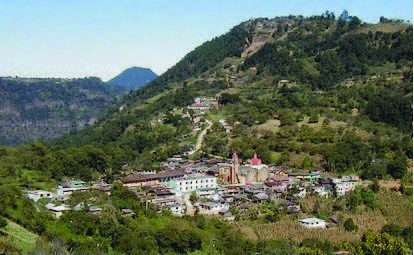 Close to Zacatlán lies the little hamlet of San Miguel Tenango, a place that had been fortified and where Beristáin went to set up an armory, a smelter and coin production facilities. He relied on the assistance of Belgian-born Pedro Lachaussée, a mining engineer. The place was in operation for many months until, on 19 May 1813, with Osorno and his main troops away on a campaign, a Royalist expedition entered Zacatlán, which had been abandoned by the remaining Insurgents on the news that the enemy was approaching. While the Spanish troops were rather surprised by their success and not numerous enough to keep the town and thus had to retreat in the following days, they were nevertheless able to destroy the fortifications and production facilities in both Zacatlán and San Miguel Tenango.
Close to Zacatlán lies the little hamlet of San Miguel Tenango, a place that had been fortified and where Beristáin went to set up an armory, a smelter and coin production facilities. He relied on the assistance of Belgian-born Pedro Lachaussée, a mining engineer. The place was in operation for many months until, on 19 May 1813, with Osorno and his main troops away on a campaign, a Royalist expedition entered Zacatlán, which had been abandoned by the remaining Insurgents on the news that the enemy was approaching. While the Spanish troops were rather surprised by their success and not numerous enough to keep the town and thus had to retreat in the following days, they were nevertheless able to destroy the fortifications and production facilities in both Zacatlán and San Miguel Tenango.
Little is known about the following months but it appears that Beristáin was unable to rebuild the fortifications and installations at San Miguel as he had to flee the place again in August in the face of another military expedition of the Royalists. After growing tensions between him and Osorno about seemingly private matters (a “question of skirts”, as Villaseñor delicately puts it), he was arrested and executed by the Insurgent leader on 9 February 1814.
There are other sources which point to coining activities in Zacatlán later in 1814, when Ignacio López Rayón was there by invitation of Osorno and had brought the silversmith and moneyer Rodriguez Alconedo with him. However, it can be safely assumed that any coins that might have been made during this period would have been either of the Tlalpujahua or of the SUD type.
We can conclude, therefore, that the minor coins struck bearing the name of Zacatlán and the monogram of Osorno most likely were produced during the time the production facilities in Zacatlán / San Miguel Tenango were in operation, that is, before May 1813. This also coincides with the dates on these coins, 1812 and 1813 (note that the Osorno monogram counterstamp is something that could have been stamped on coins at any time before, during or after the minting operations at San Miguel).
But what about our countermarked silver 8 reales? They are cast, unlike the Osorno coinage which is struck. They bear neither the Osorno monogram nor the name of the town Zacatlán. In short, they are completely unrelated in denomination, metal, production method and the symbols or signs used on them. So why would we place their coming into existence at the same time and the same
location?
It is important to realize that the Osorno-Zacatlán coinage is made of copper. Silver two reales are listed by some catalogs, but they are either excessively rare or simple cataloguing errors. From 22 bars of silver, some pieces should definitely have survived and be known today. So the important question remains - into what were the silver bars obtained in the attack on Pachuca coined?
Conclusion
I have come to the conclusion that there must have been two separate coining operations. On one side, there are the minor issues of Osorno-Zacatlán, made for local use and to facilitate everyday local commerce. They are copper coins that were produced over several months and consequently are known with the dates 1812 and 1813, coins that could serve their purpose although they were very crudely made. On the other side, the silver bars from Pachuca were transformed quickly into coins – according to Beristáin’s own report to Morelos this had already been done by November 1812, that is, within a few weeks in mid-1812. This coinage would have been made of the highest possible quality. Larger silver coins could be used for much needed investments in arms and fortifications or for purchases of goods from other regions of Mexico. For these “external trade” coins, weight, fineness and overall appearance were an important factor for their acceptance.
Nowhere in the historical documents is there any mention of coinage operations in San Martín Texmelucan. As was shown above, it remains unclear to me why such an attribution had been made in the numismatic literature of the past.
On the other side, Vicente Beristáin (“VB”) is reported to have made silver coins in San Miguel Tenango (“SM”). He had the metal to produce them, the foundry to cast them, the expertise with Don Pedro Lachaussée to produce them at a high level of quality, the workshop to mark them with counterstamps, and the time and opportunity to produce them, somewhere in late 1812.
All this coincides with the coins in question. As we can observe from the surviving specimens, the hosts are rather well made for cast coins (in comparison, for example, to the cast products of Chihuahua, Monclova and the southern Insurgents). In fact, they are so well made that some of the earlier cataloguers even failed to describe them as cast pieces! The counterstamps are strongly struck and placed on the same spot in all the coins, resulting in a very uniform issue (with the sole exception of the coin pictured from the Richard Long auction). Even some form of edge reeding was applied. All this speaks of a well-established place of manufacture and definitely not an “on-the-run” and makeshift production facility.
There is no absolute proof for my conclusion, and there most likely never will be. However, the Insurgent mint of San Miguel Tenango under the administration of Vicente Beristáin definitely is the most likely attribution for this issue. Two hundred years after coming into existence, it is about time to put both the mint of San Miguel Tenango and the corresponding coinage of Vicente Beristáin de Souza in their rightful place in the numismatic history of Mexico!
